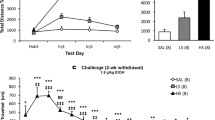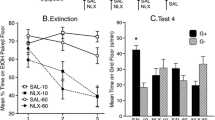Abstract
The effect of the dopamine receptor antagonist haloperidol on the development of sensitization to ethanol-induced increases in locomotor activity was examined in DBA/2J mice. In Experiment 1, different groups of mice were given saline or ethanol (2 g/kg) immediately before each of four locomotor activity sessions (48-h intervals), and 1 h after pretreatment with saline, 0.10 or 0.15 mg/kg haloperidol. During a subsequent test, mice showed locomotor sensitization despite blockade of ethanol stimulated activity by haloperidol on the first conditioning trial. Moreover, test session activity was reduced in subjects that had previously received haloperidol, even though haloperidol was not present during testing. The second experiment examined the nature of the latter finding by comparing subjects that received equal exposure to haloperidol but differed in the pairing of its administration with the activity chambers. After four conditioning trials, each group was tested in the absence of haloperidol. Mice that had previously received haloperidol paired with the activity chambers were less active than control groups, suggesting development of a conditioned suppression of activity. Overall, these results suggest a dissociation of the neurobiological mechanisms that mediate the acute locomotor stimulant effects of ethanol and those mediating sensitization. Further, these studies illustrate the importance of antagonist-alone control groups that assess the possible influence of associative learning induced by the antagonist itself.
Similar content being viewed by others
References
Andersen PH, Nielsen EB, Gronvald FC, Braestrup C (1986) Some atypical neuroleptics inhibit [3H] SCH 23390 binding in vivo. Eur J Pharmacol 120:143–144
Antelman SM, Kocan D, Edwards DJ, Knopf S, Perel JM, Stiller R (1986) Behavioral effects of a single neuroleptic treatment grow with the passage of time. Brain Res 385:58–67
Blackman DE (1989) Behavioral tolerance and sensitization. In: Goudie AJ, Emmett-Oglesby MW (eds) Psychoactive drugs. Tolerance and sensitization. Humana Press, Clifton, N.J., pp 522–544
Carey RJ, DeVeaugh-Geiss J (1984) Treatment schedule as a determinant of the development of tolerance to haloperidol. Psychopharmacology 82:164–167
Crabbe JC Jr, Johnson NA, Gray DK, Kosobud A, Young ER (1982) Biphasic effects of ethanol on open-field activity: sensitization and tolerance in C57BL/6N and DBA/2N mice. J Comp Physiol Psychol 96:440–451
Cunningham CL, Noble D (1992) Conditioned activation induced by ethanol: role in sensitization and conditioned place preference. Pharmacol Biochem Behav 43:307–313
Cunningham CL, Prather LK (1992) Conditioned trial duration affects ethanol-induced conditioned place preference in mice. Anim Learn Behav 20:187–194
Cunningham CL, Malott DH, Dickinson SD, Risinger FO (1992) Haloperidol does not alter expression of ethanol-induced conditioned place preference. Behav Brain Res 50:1–5
Frye GD, Breese GR (1981) An evaluation of the locomotor stimulating action of ethanol in rats and mice. Psychopharmacology 75:372–379
Horger BA, Shelton K, Schenk S (1990) Preexposure sensitizes rats to the rewarding effects of cocaine. Pharmacol Biochem Behav 37:707–711
Hunt WA, Lands WEM (1992) A role for behavioral sensitization in uncontrolled ethanol intake. Alcohol 9:327–328
Imperato A, Di Chiara G (1986) Preferential stimulation of dopamine release in nucleus accumbens of freely moving rats by ethanol. J Pharmacol Exp Ther 239:219–228
Kalivas PW, Sorg BA, Hooks MS (1993) The pharmacology and neural circuitry of sensitization to psychostimulants. Behav Pharmacol 4:315–334
Karler R, Calder LD, Chaudhry IA, Turkanis SA (1989) Blockade of “reverse tolerance” to cocaine and amphetamine by MK-801. Life Sci 45:599–606
Khanna JW, Morato GS, Chau A, Shah G, Kalant H (1994) Effect of NMDA antagonists on rapid and chronic tolerance to ethanol: importance of intoxicated practice. Pharmacol Biochem Behav 48:755–763
Lett BW (1989) Repeated exposures intensify rather than diminish the rewarding effects of amphetamine, morphine, and cocaine. Psychopharmacology 98:357–362
Lewis MJ, June HL (1990) Neurobehavioral studies of ethanol reward and activation. Alcohol 7:213–219
Liljequist S, Berggren U, Engel J (1981) The effects of catecholamine receptor antagonists on ethanol-induced locomotor stimulation. J Neural Transm 50:57–67
Lister RG (1987) The effects of repeated doses of ethanol on exploration and its habituation. Psychopharmacology 92:78–83
Masuda Y, Murai S, Itoh T (1982) Tolerance and reverse tolerance to haloperidol catalepsy induced by the difference of administration interval in mice. Jpn J Pharmacol 32:1186–1188
Masur J, De Souza MLO, Zwicker AP (1986) The excitatory effect of ethanol: absence in rats, no tolerance and increased sensitivity in mice. Pharmacol Biochem Behav 23:1225–1228
Phillips TJ, Dudek BC (1991) Locomotor activity response to ethanol in selectively bred long-and short-sleep mice, two inbred mouse strains, and their F1 hybrids. Alcohol Clin Exp Res 15:255–261
Phillips TJ, Burkhart-Kasch S, Crabbe JC (1991) Locomotor activity response to chronic ethanol treatment in selectively bred FAST and SLOW mice. Alcohol Alcohol 1[suppl]:109–113
Phillips TJ, Dickinson S, Burkhart-Kasch S (1994) Behavioral sensitization to drug stimulant effects in C57BL/6J and DBA/2J inbred mice. Behav Neurosci 108:789–803
Piazza PV, Deminiere JM, Le Moal M, Simon H (1990) Stress-and pharmacologically-induced behavioral sensitization increases vulnerability to acquisition of amphetamine self-administration. Brain Res 514:22–26
Risinger FO, Dickinson SD, Cunningham CL (1992a) Haloperidol reduces ethanol-induced motor activity stimulation but not conditioned place preference. Psychopharmacology 107:453–456
Risinger FO, Malott DH, Riley AL, Cunningham CL (1992b) Effect of Ro 15-4513 on ethanol-induced conditioned place preference. Pharmacol Biochem Behav 43:97–102
Robinson TE, Berridge KC (1993) The neural basis of drug craving: an incentive-sensitization theory of addiction. Brain Res Rev 18:247–291
Stewart J, Badiani A (1993) Tolerance and sensitization to the behavioral effects of drugs. Behav Pharmacol 4:289–312
Vezina P, Stewart J (1989) The effects of dopamine receptor blockade on the development of sensitization to the locomotor activating effects of amphetamine and morphine. Brain Res 499:108–120
Woolverton WL, Cervo L, Johanson CE (1984) Effects of repeated methamphetamine administration on methamphetamine self-administration in Rhesus monkeys. Pharmacol Biochem Behav 21:737–741
Zetler G, Baumann GH (1985) Pharmacokinetics and effect of haloperidol in the isolated mouse. Pharmacology 31:318–327
Author information
Authors and Affiliations
Rights and permissions
About this article
Cite this article
Broadbent, J., Grahame, N.J. & Cunningham, C.L. Haloperidol prevents ethanol-stimulated locomotor activity but fails to block sensitization. Psychopharmacology 120, 475–482 (1995). https://doi.org/10.1007/BF02245821
Received:
Revised:
Issue Date:
DOI: https://doi.org/10.1007/BF02245821




